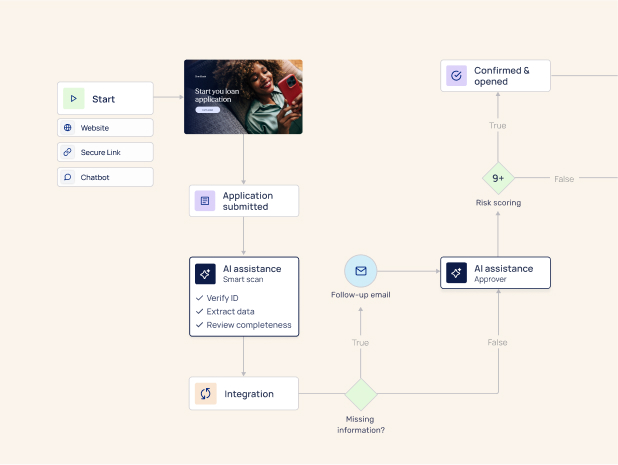Collecting data directly from customers is the necessary first step for many core business processes in insurance and financial services.
This presents a challenge to customer experience - nobody likes filling in lengthy and frustrating forms. The process is further complicated if data needs to be collected across multiple channels: in-person, online, or over the phone.
Customer data collection necessitates a delicate balancing act for businesses: on the one hand, you need to collect accurate and up-to-date customer data, on the other, you need to make sure the process is as smooth, seamless and painless as possible.
Here are a few tips on how to get customer data collection right:
1. Keep it short and sweet
The best way to collect customer data is to keep the process short and sweet. The shorter the form, the more likely customers will be to fill it in.
Of course, you still need to collect enough data for your process, be it FNOL, policy purchase or personal details update. In general, it's better to ask as few data points as possible and to give customers the option to provide more information if they want to.
Utilize the data you already collected by ensuring two-way integration with your core systems so that you don’t have to ask for the same information twice. Utilize third-party data sources where possible.
2. Use progressive profiling
Progressive profiling is a technique that allows you to gradually collect more information about customers as they engage with your organization.
The key is that you don’t ask for the information you already know, so if you have the data in your CRM, you skip the corresponding question for the customer. For instance, you might start by asking for a customer's name and contact details. Once they have provided this information, you can ask for additional information such as their date of birth or policy number. If you already have that info, your customer skips to the next step in the process.
This approach allows you to avoid asking for too much information up front, and ensures that customers only provide the information that is absolutely necessary.
3. Use clear and concise language
The language you use in all of your communications with customers, including your data collection forms, will have a big impact on how likely they are to engage with you.
Use clear and concise language that is easy to understand, and avoid jargon or technical terms. It should be obvious what information you are asking for and why at every step of the data collection journey.
4. Dynamically adjust to each customer
Your customer data collection process should be flexible and adjust in real-time based on customer input.
For instance, if a customer indicates that they are not married, do not ask them for their spouse's name or information. Dynamic form customization will make the process quicker and easier for customers, and will result in higher-quality data.
5.Validate at the point of entry
The average insurance organization generates 2.5PB of data per year, however, only half of this data is usable. The remaining data is either duplicative, irrelevant or of poor quality.
Data entry errors are one of the most common problems with customer data collection that results in bad data. To reduce the risk of errors, validate customer data at the point of entry.
This means checking that the format is correct (for instance, that a phone number has the correct number of digits), and that the data is within the expected range (for instance, that a date of birth is in the past).
Customize validation rules to the needs of your business, for example, by adding a 'check digit' validation to a policy number. Ensure that the online data collection tools you use support not only the pre-built validation rules, but also give you the option to customize and modify as needed.
6. Utilize different field types for different questions
When customers need to select from a list of provided options, the drop-down menus are one of the quickest and easiest ways to collect customer data accurately.
If you need to collect open-ended information from customers, use a text box with clear instructions on the format that the data should be entered in.
If you are asking for a date of birth, make it clear that the format should be DD/MM/YYYY.
Utilizing different field types for different questions will make the data collection process quicker and easier for customers, and will result in higher-quality data.
7. Offer multiple channels for data collection
In today's digital world, it's important to offer customers multiple channels for data collection.
Customers should be able to provide information in-person, online, or over the phone – whichever is most convenient for them. If possible, allow customers to start the process on one channel and finish on another.

8. Use visual cues
Use visual cues to guide customers through the data collection process and make it clear what information is required at each step.
For instance, use color-coding to highlight required fields, or use an asterisk (*) to denote required information. You can also use placeholders to give customers an idea of the expected format for data entry.
9. Offer customer support
If customers have questions or run into problems when completing your data collection form, offer customer support.
This could be in the form of a live chat widget, or a phone number that they can call. Online data collection tools will also have built-in customer support features that you can use.
Co-browsing is a customer support tool that allows agents to see what the customer is seeing on their screen in real-time. This can be used to quickly resolve any issues that the customer is having with the data collection process.
10. Allow customers to review and edit their data
Once customers have submitted their data, give them the option to review and edit it before it is finalized. This will help to ensure that the data is accurate and complete, and reduce the need for follow-up communications or corrections.
11. Use data collection tools that integrate with your systems
The customer data you collect should be integrated into your core business systems, such as your CRM or marketing automation platform. This will make it easier to use and manage the data, and will make sure that it is accessible to the people who need it.
12. Collect data in a format that is easy to use
The format of the data you collect is just as important as the quality. Collecting data in a format that is difficult to use will make it hard to get value from it. Make sure to collect data in a structured format (such as CSV or JSON) that can be easily imported into your systems.
13. Use data collection tools that are GDPR compliant
If you collect data from customers in the European Union, you need to make sure that your data collection process is GDPR compliant. This includes getting explicit consent from customers before collecting their data, and providing them with the option to opt-out at any time.
14. Keep your data secure
Data security is critical when collecting customer data. Make sure to use encryption to protect customer data in transit, and choose a data storage solution that meets your security needs.
15. Put customers first
The most important thing to remember when collecting customer data is to put customers first. The goal should be to make the process as smooth and painless as possible for them. By following these tips, you can ensure that your customer data collection process is effective and efficient, and that your customers will be happy to provide you with the information you need.
Things to avoid when collecting customer data:
Getting data collection right is essential to ensuring that you are able to get the most value from the information you collect. There are a few things to avoid if you want to make sure that your data collection process is effective:
- Only collect the data that you actually need. Collecting too much data can be a burden on your systems, and make it more difficult to find the information you need.
- Make sure that you have the ability to actually use the data you collect. This means having the right systems and processes in place to store, manage, and analyze the data.
- The process of collecting customer data should be as smooth and painless as possible. If it is too difficult or time-consuming, people will be less likely to provide their information.
It is essential to remember that when collecting customer data, the goal should always be to put customers first. By following these tips, you can ensure that your customer data collection process is effective and efficient, and that your customers will be happy to provide you with the information you need. Remembering these guidelines will help you get the most value from the customer data you collect.





